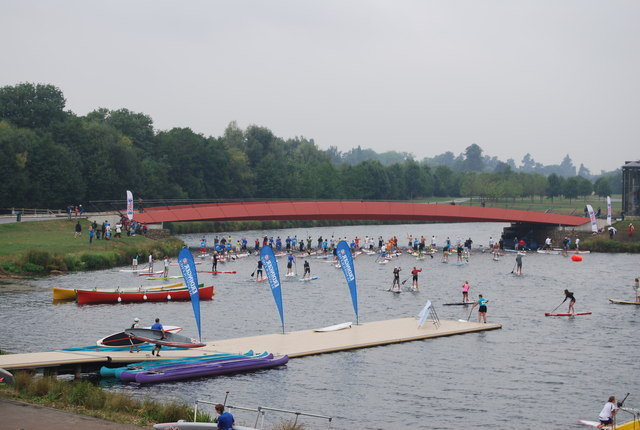
Stand-up paddleboarding (SUP) races are becoming increasingly popular as more people discover the thrill of competing on the water. If you’re considering participating in a SUP race, proper training and preparation are essential for success, and there are many paddleboard exercises for enhancing athletic performance. In this article, we’ll discuss some key aspects of SUP race training and offer tips on how to prepare for the big day. So, let’s dive in!
Choosing the Right Equipment
Selecting the appropriate paddleboard is crucial for race performance. Rock and Mountain offers a wide range of paddleboards to suit your needs. Here are a few factors to consider when choosing a race board:
- Board type: Race-specific boards are typically longer, narrower, and have a pointed nose to promote speed and glide. Be sure to choose a board designed for racing to maximise your performance.
- Board size: Select a board that suits your height, weight, and skill level. A larger board will offer more stability, while a smaller board will provide greater manoeuvrability.
- Paddle: Choose a lightweight, ergonomic paddle that allows for efficient and powerful strokes.
The world of paddleboard racing, is oftne the first place you will see new technology and future developments in stand up paddleboarding.
Developing an Effective Training Plan
A well-rounded SUP race training plan should focus on building endurance, strength, and technique. Here are some key elements to include in your training:
- Endurance training: Schedule regular long-distance paddles to build your cardiovascular endurance. Aim for at least one long paddle per week, gradually increasing the distance as your fitness improves.
- Interval training: Incorporate high-intensity interval training (HIIT) into your routine to boost your speed and power. Perform short, intense bursts of paddling followed by recovery periods.
- Strength training: Enhance your overall strength and stability with targeted workouts, focusing on your core, upper body, and legs.
- Technique drills: Practise specific paddleboarding techniques, such as buoy turns, drafting, and efficient paddle strokes, to improve your performance on race day.
Nutrition and Hydration
Proper nutrition and hydration are essential for optimal race performance. Here are some tips for fuelling your body during training and on race day:
- Balanced diet: Maintain a healthy, balanced diet that provides adequate carbohydrates, proteins, and fats to support your training.
- Pre-race meal: Consume a meal rich in carbohydrates 2-3 hours before the race to ensure you have sufficient energy.
- Hydration: Drink plenty of water during training and on race day, aiming to consume at least 500ml of water per hour of paddling.
Pre-Race Preparation
In the weeks leading up to the race, focus on the following aspects to ensure you’re fully prepared:
- Tapering: Gradually reduce your training volume and intensity to allow your body to recover and be at its best on race day.
- Race course familiarisation: If possible, visit the race location and familiarise yourself with the course, including any turns, obstacles, or challenging sections.
- Equipment check: Inspect your paddleboard, paddle, and any other race gear to ensure everything is in good condition.
- Race day strategy: Develop a race plan, including your pacing strategy, drafting tactics, and when to push for the finish.
By focusing on these key elements of SUP race training and preparation, you’ll be well-equipped to perform at your best on race day. Remember that practice makes perfect, so stay consistent with your training and enjoy the process. Be sure to visit the Rock and Mountain blog for more tips and advice on paddle boarding and water sports.
Mental Preparation
Your mental game is just as important as your physical preparation when it comes to SUP racing. Cultivating a strong mindset will help you stay focused and confident during the race. Consider incorporating these mental training strategies:
- Goal setting: Set realistic yet challenging goals for your race performance, such as completing the race within a specific time or improving upon your previous personal best.
- Visualisation: Regularly visualise yourself successfully completing the race, navigating challenging sections, and maintaining a strong, steady pace throughout.
- Positive self-talk: Develop a set of positive affirmations or motivational phrases that you can repeat to yourself during training and on race day to stay focused and confident.
- Breathing techniques: Practise deep, controlled breathing to help calm nerves and maintain focus during the race.
Post-Race Recovery
After completing your SUP race, it’s crucial to give your body time to recover and repair. Here are some recovery strategies to implement after your race:
- Cool down: Paddle at a slow, relaxed pace for 10-15 minutes after the race to help your body cool down and flush out any lactic acid build-up.
- Stretching: Spend 10-15 minutes stretching your major muscle groups, focusing on your shoulders, back, hips, and legs.
- Hydration and refuelling: Replenish your body with water, electrolytes, and a balanced meal that includes carbohydrates, protein, and fats.
- Rest and relaxation: Give yourself time to rest and recover, allowing your body to heal and adapt to the demands of the race.
SUP racing can be an exhilarating and rewarding experience, providing an opportunity to challenge yourself and connect with other like-minded paddleboard enthusiasts. By following these tips for race training and preparation, you’ll be well on your way to a successful SUP racing experience. Don’t forget to check out Rock and Mountain’s extensive range of paddleboards to find the perfect board for your racing needs and explore their blog for more expert advice on all things paddleboarding. Good luck, and happy paddling!

